The Role of Mesoscale Dynamics over Northwestern Cuba in the Loop Current Evolution in 2010, during the Deepwater Horizon Incident
Abstract
1. Introduction
2. Data and Methods
2.1. Model Description
2.2. Observational Data
2.2.1. Remote Sensing
2.2.2. In Situ Observations
3. Results
3.1. Model Evaluation
3.2. Loop Current System Evolution
3.3. Evolution of Cuba Anticyclones (CubANs)
3.3.1. CubAN Period Event E1: Extended LC
3.3.2. CubAN Period Event E3: Eddy Franklin Re-Attachment
4. Discussion
4.1. Connection between CubANs and Loop Current (E1 Period)
4.2. Contribution of Coastal Upwelling to CubAN Separation (E3 Period)
5. Conclusions
Author Contributions
Funding
Institutional Review Board Statement
Informed Consent Statement
Data Availability Statement
Acknowledgments
Conflicts of Interest
Appendix A

References
- Crone, T.J.; Tolstoy, M. Magnitude of the 2010 Gulf of Mexico oil leak. Science 2010, 330, 634. [Google Scholar] [CrossRef]
- Liu, Y.Y.; Weisberg, R.H.; Hu, C.C.; Kovach, C.C.; RiethmüLler, R.R. Evolution of the Loop Current system during the Deepwater Horizon oil spill event as observed with drifters and satellites. Monit. Model. Deep. Horiz. Oil Spill Record-Break. Enterp. 2011, 195, 91–101. [Google Scholar]
- Le Hénaff, M.; Kourafalou, V.H.; Paris, C.B.; Helgers, J.; Aman, Z.M.; Hogan, P.J.; Srinivasan, A. Surface evolution of the Deepwater Horizon oil spill patch: Combined effects of circulation and wind-induced drift. Environ. Sci. Technol. 2012, 46, 7267–7273. [Google Scholar] [CrossRef] [PubMed]
- Walker, N.D.; Pilley, C.T.; Raghunathan, V.V.; D’Sa, E.J.; Leben, R.R.; Hoffmann, N.G.; Brickley, P.J.; Coholan, P.D.; Sharma, N.N.; Graber, H.C.; et al. Impacts of Loop Current frontal cyclonic eddies and wind forcing on the 2010 Gulf of Mexico oil spill. Monit. Model. Deep. Horiz. Oil Spill Record-Break. Enterp. 2011, 195, 103–116. [Google Scholar]
- Leben, R.R. Altimeter-Derived Loop Current Metrics. Circ. Gulf Mex. Obs. Model. 2005, 161, 181–201. [Google Scholar]
- Schmitz, W.J. Cyclones and westward propagation in the shedding of anticyclonic rings from the Loop Current. Circ. Gulf Mex. Obs. Model. 2005, 161, 241–261. [Google Scholar]
- Lugo-Fernández, A.; Badan, A. On the vorticity cycle of the Loop Current. J. Mar. Res. 2007, 65, 471–489. [Google Scholar] [CrossRef]
- Hamilton, P.; Donohue, K.A.; Leben, R.R.; Lugo-Fernández, A.; Green, R.E. Loop Current observations during spring and summer of 2010: Description and historical perspective. Monit. Model. Deep. Horiz. Oil Spill Record-Break. Enterp. Geophys. Monogr. Ser. 2011, 195, 117–130. [Google Scholar]
- Sturges, W.; Leben, R. Frequency of ring separations from the Loop Current in the Gulf of Mexico: A revised estimate. J. Phys. Oceanogr. 2000, 30, 1814–1819. [Google Scholar] [CrossRef]
- Hurlburt, H.E.; Thompson, J.D. A numerical study of Loop Current intrusions and eddy shedding. J. Phys. Oceanogr. 1980, 10, 1611–1651. [Google Scholar] [CrossRef]
- Pichevin, T.; Nof, D. The momentum imbalance paradox. Tellus A 1997, 49, 298–319. [Google Scholar] [CrossRef]
- Candela, J.; Sheinbaum, J.; Ochoa, J.; Badan, A.; Leben, R. The potential vorticity flux through the Yucatan Channel and the Loop Current in the Gulf of Mexico. Geophys. Res. Lett. 2002, 29, 16-1–16-4. [Google Scholar] [CrossRef]
- Oey, L.Y.; Lee, H.C.; Schmitz, W.J. Effects of winds and Caribbean eddies on the frequency of Loop Current eddy shedding: A numerical model study. J. Geophys. Res. Oceans 2003, 108. [Google Scholar] [CrossRef]
- Chérubin, L.M.; Morel, Y.; Chassignet, E.P. Loop Current ring shedding: The formation of cyclones and the effect of topography. J. Phys. Oceanogr. 2006, 36, 569–591. [Google Scholar] [CrossRef]
- Weisberg, R.H.; Liu, Y. On the Loop Current penetration into the Gulf of Mexico. J. Geophys. Res. Oceans 2017, 122, 9679–9694. [Google Scholar] [CrossRef]
- Le Hénaff, M.; Kourafalou, V.H.; Dussurget, R.; Lumpkin, R. Cyclonic activity in the eastern Gulf of Mexico: Characterization from along-track altimetry and in situ drifter trajectories. Prog. Oceanogr. 2014, 120, 120–138. [Google Scholar] [CrossRef]
- Androulidakis, Y.S.; Kourafalou, V.H.; Le Hénaff, M. Influence of frontal cyclones evolution on the 2009 (Ekman) and 2010 (Franklin) Loop Current Eddy detachment events. Ocean Sci. Discuss. 2014, 11, 947–965. [Google Scholar] [CrossRef]
- Donohue, K.A.; Watts, D.R.; Hamilton, P.; Leben, R.; Kennelly, M. Loop current eddy formation and baroclinic instability. Dyn. Atmos. Oceans 2016, 76, 195–216. [Google Scholar] [CrossRef]
- Donohue, K.A.; Watts, D.R.; Hamilton, P.; Leben, R.; Kennelly, M.; Lugo-Fernández, A. Gulf of Mexico loop current path variability. Dyn. Atmos. Oceans 2016, 76, 174–194. [Google Scholar] [CrossRef]
- Kourafalou, V.; Androulidakis, Y.; Le Hénaff, M.; Kang, H. The Dynamics of Cuba Anticyclones (CubANs) and Interaction with the Loop Current/Florida Current System. J. Geophys. Res. Oceans 2017, 122, 7897–7923. [Google Scholar] [CrossRef]
- Le Hénaff, M.; Kourafalou, V.H.; Androulidakis, Y.; Smith, R.H.; Kang, H.; Hu, C.; Lamkin, J.T. In situ measurements of circulation features influencing cross-shelf transport around northwest Cuba. J. Geophys. Res. Oceans 2020, 125, e2019JC015780. [Google Scholar] [CrossRef]
- Le Hénaff, M.; Kourafalou, V.H.; Morel, Y.; Srinivasan, A. Simulating the dynamics and intensification of cyclonic Loop Current Frontal Eddies in the Gulf of Mexico. J. Geophys. Res. 2012, 117, C02034. [Google Scholar] [CrossRef]
- Androulidakis, Y.; Kourafalou, V.; Le Hénaff, M.; Kang, H.; Ntaganou, N.; Hu, C. Gulf Stream evolution through the Straits of Florida: The role of eddies and upwelling near Cuba. Ocean Dyn. 2020, 70, 1005–1032. [Google Scholar] [CrossRef]
- Gula, J.; Molemaker, M.J.; McWilliams, J.C. Topographic vorticity generation, submesoscale instability and vortex street formation in the Gulf Stream. Geophys. Res. Lett. 2015, 42, 4054–4062. [Google Scholar] [CrossRef]
- Gula, J.; Molemaker, M.J.; McWilliams, J.C. Topographic generation of submesoscale centrifugal instability and energy dissipation. Nat. Commun. 2016, 7, 12811. [Google Scholar] [CrossRef]
- Androulidakis, Y.; Kourafalou, V.; Robert Hole, L.; Le Hénaff, M.; Kang, H. Pathways of Oil Spills from Potential Cuban Offshore Exploration: Influence of Ocean Circulation. J. Mar. Sci. Eng. 2020, 8, 535. [Google Scholar] [CrossRef]
- Le Hénaff, M.; Kourafalou, V.H. Mississippi waters reaching South Florida reefs under no flood conditions: Synthesis of observing and modeling system findings. Ocean Dyn. 2016, 66, 435–459. [Google Scholar] [CrossRef]
- Bleck, R. An oceanic general circulation model framed in hybrid isopycnic-Cartesian coordinates. Ocean Model. 2002, 4, 55–88. [Google Scholar] [CrossRef]
- Counillon, F.; Bertino, L. High-resolution ensemble forecasting for the Gulf of Mexico eddies and fronts. Ocean Dyn. 2009, 59, 83–95. [Google Scholar] [CrossRef]
- Schiller, R.V.; Kourafalou, V.H. Loop Current impact on the transport of Mississippi River waters. J. Coast. Res. 2014, 30, 1287–1306. [Google Scholar] [CrossRef]
- Mezić, I.; Loire, S.; Fonoberov, V.A.; Hogan, P. A new mixing diagnostic and Gulf oil spill movement. Science 2010, 330, 486–489. [Google Scholar] [CrossRef]
- Mariano, A.J.; Kourafalou, V.H.; Srinivasan, A.; Kang, H.; Halliwell, G.R.; Ryan, E.H.; Roffer, M. On the modeling of the 2010 Gulf of Mexico oil spill. Dyn. Atmos. Ocean 2011, 52, 322–340. [Google Scholar] [CrossRef]
- Kourafalou, V.H.; Androulidakis, Y.S. Influence of Mississippi River induced circulation on the Deepwater Horizon oil spill transport. J. Geophys. Res. Oceans 2013, 118, 3823–3842. [Google Scholar] [CrossRef]
- Schiller, R.V.; Kourafalou, V.H. Modeling river plume dynamics with the HYbrid Coordinate Ocean Model. Ocean Model. 2010, 33, 101–117. [Google Scholar] [CrossRef]
- Halliwell, G.R., Jr.; Srinivasan, A.; Kourafalou, V.; Yang, H.; Willey, D.; Le Hénaff, M.; Atlas, R. Rigorous evaluation of a fraternal twin ocean OSSE system for the open Gulf of Mexico. J. Atmos. Ocean. Technol. 2014, 31, 105–130. [Google Scholar] [CrossRef]
- Halliwell, G.R., Jr.; Kourafalou, V.; Le Hénaff, M.; Shay, L.K.; Atlas, R. OSSE impact analysis of airborne ocean surveys for improving upper-ocean dynamical and thermodynamical forecasts in the Gulf of Mexico. Prog. Oceanogr. 2015, 130, 32–46. [Google Scholar] [CrossRef]
- Hu, C. An empirical approach to derive MODIS ocean color patterns under severe sun glint. Geophys. Res. Lett. 2011, 38, L01603. [Google Scholar] [CrossRef]
- Briggs, K.; Smith, S.R.; Rolph, J.J. 2011 SAMOS Data Quality Report; COAPS: Tallahassee, FL, USA, 2012; p. 140. [Google Scholar]
- Shay, L.K.; Jaimes, B.; Brewster, J.K.; Meyers, P.; McCaskill, E.C.; Uhlhorn, E.; Marks, F.; Halliwell, G.R., Jr.; Smedstad, O.M.; Hogan, P. Airborne ocean surveys of the Loop Current complex from NOAA WP-3D in support of the Deepwater Horizon oil spill. Monit. Model. Deep. Horiz. Oil Spill Record-Break. Enterp. 2011, 195, 131–151. [Google Scholar]
- Androulidakis, Y.; Kourafalou, V.; Le Hénaff, M.; Kang, H.; Sutton, T.; Chen, S.; Hu, C.; Ntaganou, N. Offshore spreading of Mississippi waters: Pathways and vertical structure under eddy influence. J. Geophys. Res. Oceans 2019, 124, 5952–5978. [Google Scholar] [CrossRef]
- Thomson, R.E.; Emery, W.J. Data Analysis Methods in Physical Oceanography; Newnes: Oxford, UK, 2014. [Google Scholar]
- Smith, N.P. Temporal and spatial characteristics of summer upwelling along Florida’s Atlantic shelf. J. Phys. Oceanogr. 1983, 13, 1709–1715. [Google Scholar] [CrossRef][Green Version]
- Hsuesh, Y.; O’Brien, J.J. Steady coastal upwelling induced by an along-shore current. J. Phys. Oceanogr. 1971, 1, 180–186. [Google Scholar]
- Kourafalou, V.H.; Androulidakis, Y.S.; Kang, H.; Smith, R.H.; Valle-Levinson, A. Physical connectivity between Pulley Ridge and Dry Tortugas coral reefs under the influence of the Loop Current/Florida Current system. Prog. Oceanogr. 2018, 165, 75–99. [Google Scholar] [CrossRef]
- Sponaugle, S.; Lee, T.N.; Kourafalou, V.H.; Pinkard, D. Florida Current frontal eddies and the settlement of coral reef fishes. Limnol. Oceanogr. 2005, 50, 1033–1048. [Google Scholar] [CrossRef]
- Kourafalou, V.H.; Kang, H. Florida Current meandering and evolution of cyclonic eddies along the Florida Keys Reef Tract: Are they interconnected? J. Geophys. Res. Oceans 2012, 117. [Google Scholar] [CrossRef]
- Baringer, M.O.N.; Larsen, J.C. Sixteen years of Florida Current transport at 27 N. Geophys. Res. Lett. 2001, 28, 3179–3182. [Google Scholar] [CrossRef]
- Candela, J.; Ochoa, J.; Sheinbaum, J.; Lopez, M.; Perez-Brunius, P.; Tenreiro, M.; Pallàs-Sanz, E.; Athié, G.; Arriaza-Oliveros, L. The flow through the gulf of Mexico. J. Phys. Oceanogr. 2019, 49, 1381–1401. [Google Scholar] [CrossRef]
- Alves, T.M.; Kokinou, E.; Zodiatis, G.; Radhakrishnan, H.; Panagiotakis, C.; Lardner, R. Multidisciplinary oil spill modeling to protect coastal communities and the environment of the Eastern Mediterranean Sea. Sci. Rep. 2016, 6, 1–9. [Google Scholar] [CrossRef] [PubMed]
- Alves, T.M.; Kokinou, E.; Zodiatis, G.; Lardner, R.; Panagiotakis, C.; Radhakrishnan, H. Modelling of oil spills in confined maritime basins: The case for early response in the Eastern Mediterranean Sea. Environ. Pollut. 2015, 206, 390–399. [Google Scholar] [CrossRef] [PubMed]
- Pålsson, J. Oil Spill Preparedness in the Baltic Sea Countries; Baltic Master II Project; World Maritime University: Malmö, Sweden, 2012; 42p. [Google Scholar]
- Barker, C.H.; Kourafalou, V.H.; Beegle-Krause, C.J.; Boufadel, M.; Bourassa, M.A.; Buschang, S.G.; Androulidakis, Y.; Chassignet, E.P.; Dagestad, K.F.; Danmeier, D.G.; et al. Progress in Operational Modeling in Support of Oil Spill Response. J. Mar. Sci. Eng. 2020, 8, 668. [Google Scholar] [CrossRef]
- Sepp Neves, A.A.; Pinardi, N.; Navarra, A.; Trotta, F. A general methodology for beached oil spill hazard mapping. Front. Mar. Sci. 2020, 7, 65. [Google Scholar] [CrossRef]
- Zodiatis, G.; Radhakrishnan, H.; Georgoudis, E.; Sotillo, M.; Lardner, R.W.; Krokos, G.; Bruciaferri, D. The Mediterranean Decision Support System for Marine Safety dedicated to oil slicks predictions. Deep-Sea Res. II 2016. [Google Scholar] [CrossRef]
- Garraffo, Z.D.; Mariano, A.J.; Griffa, A.; Veneziani, C.; Chassignet, E.P. Lagrangian data in a high-resolution numerical simulation of the North Atlantic: I. Comparison with in situ drifter data. J. Mar. Syst. 2001, 29, 157–176. [Google Scholar] [CrossRef]
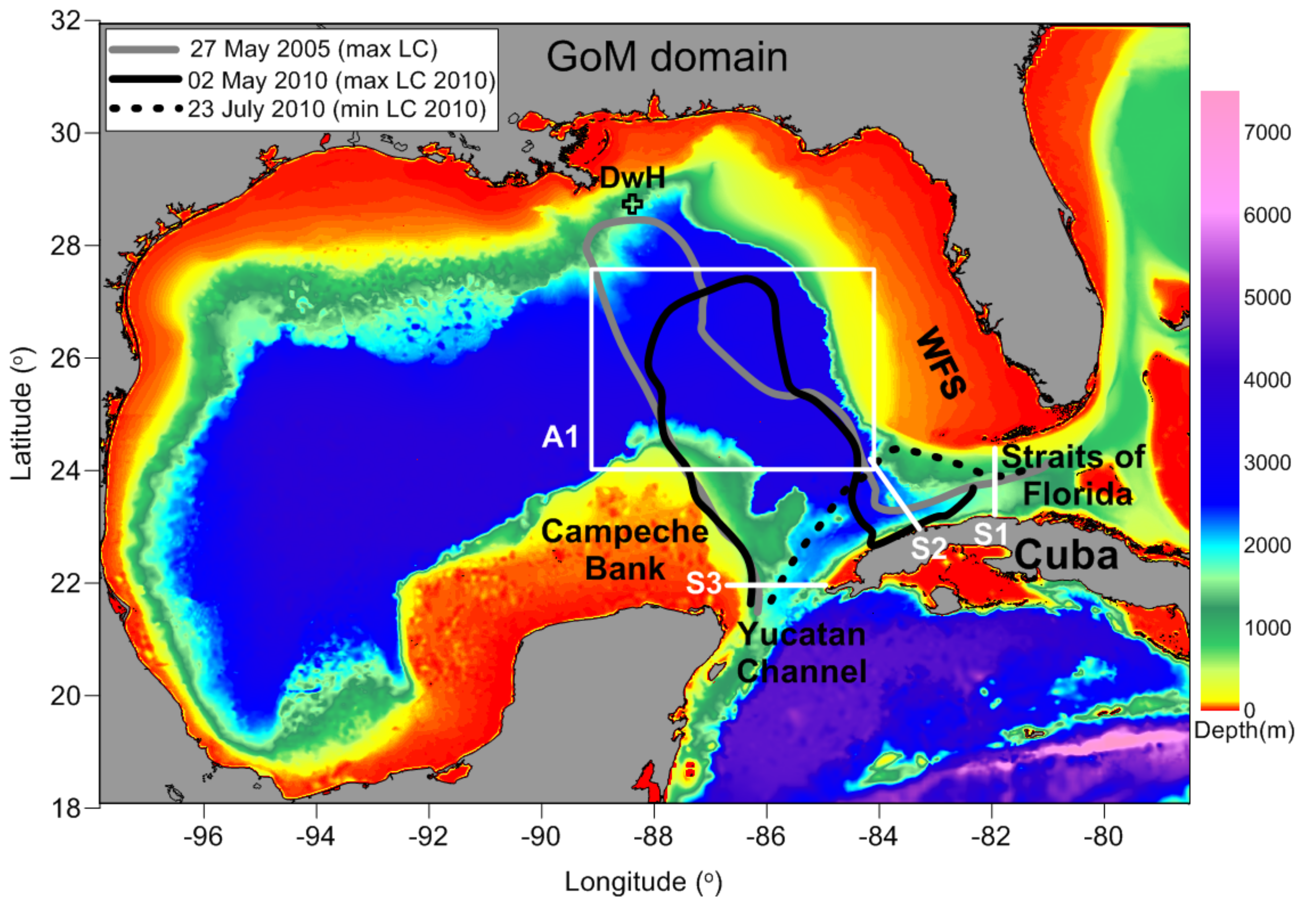
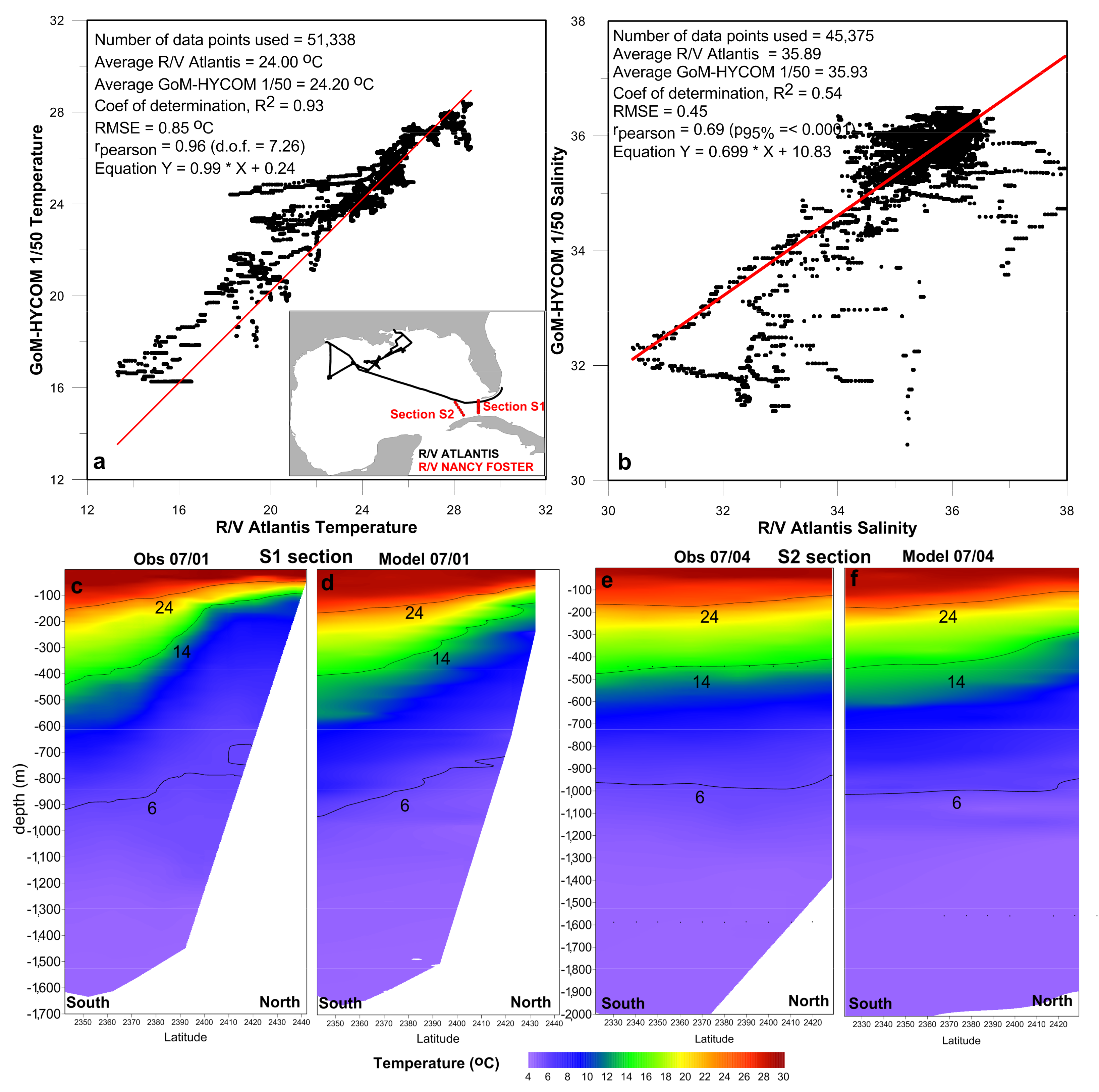
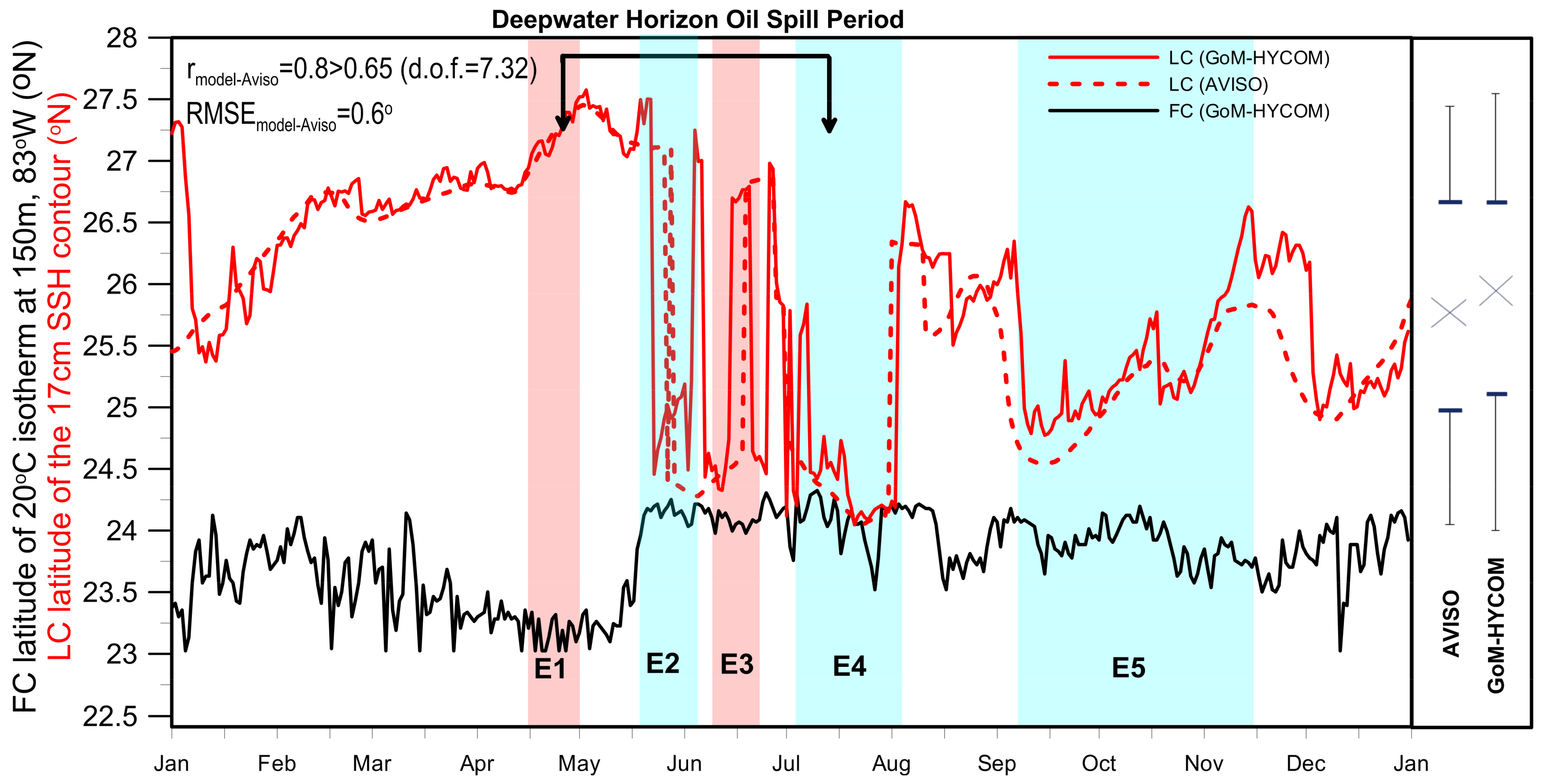
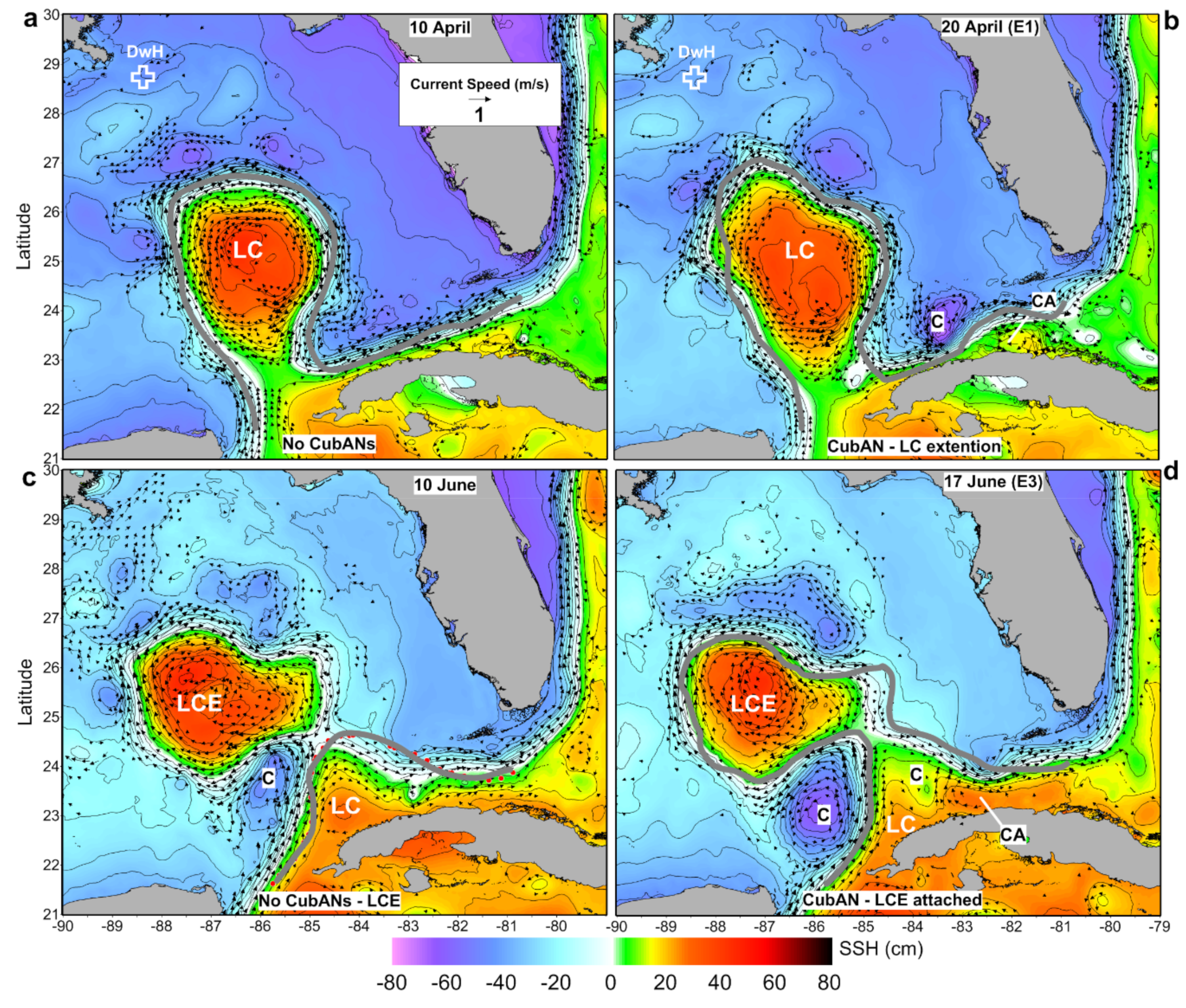

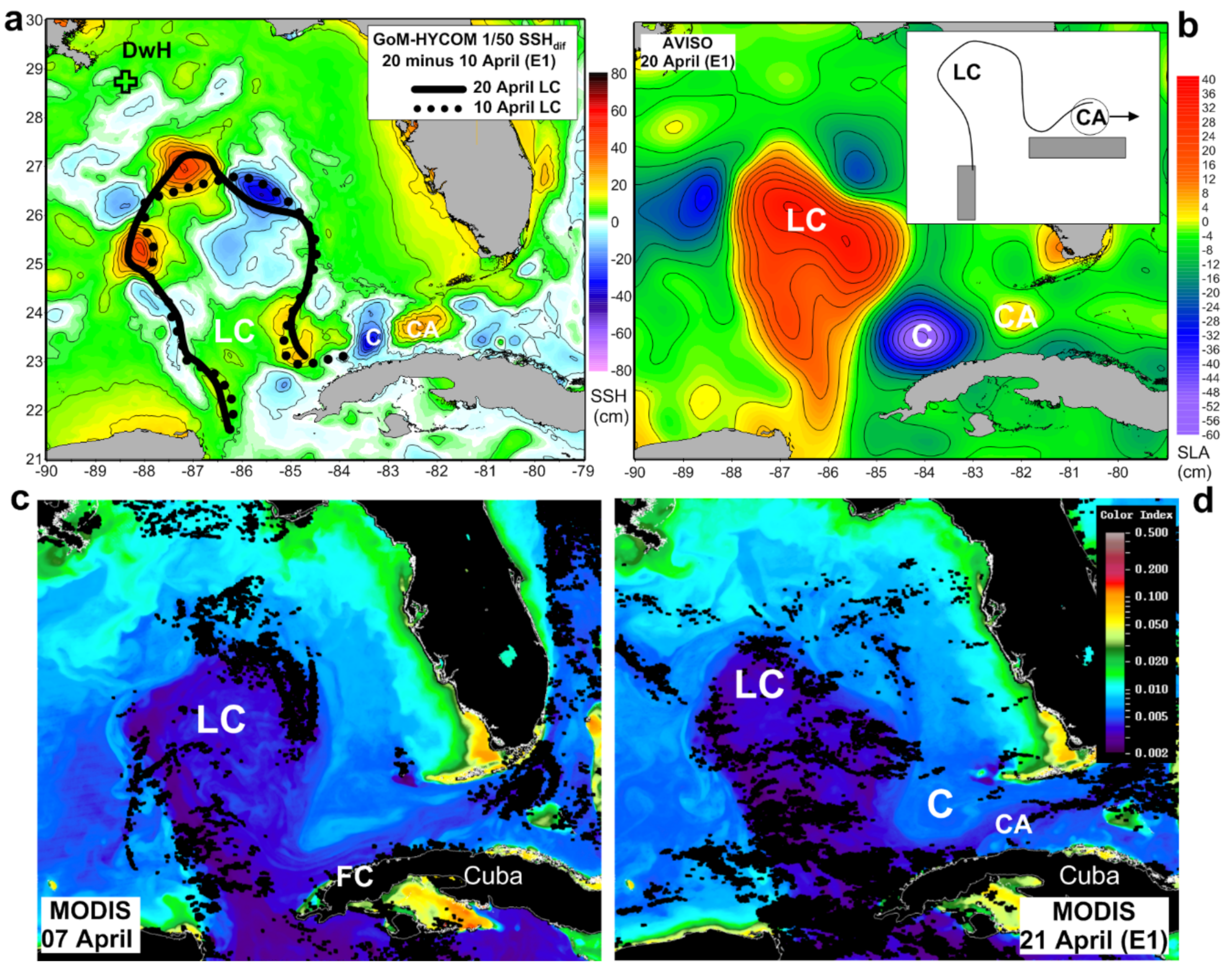
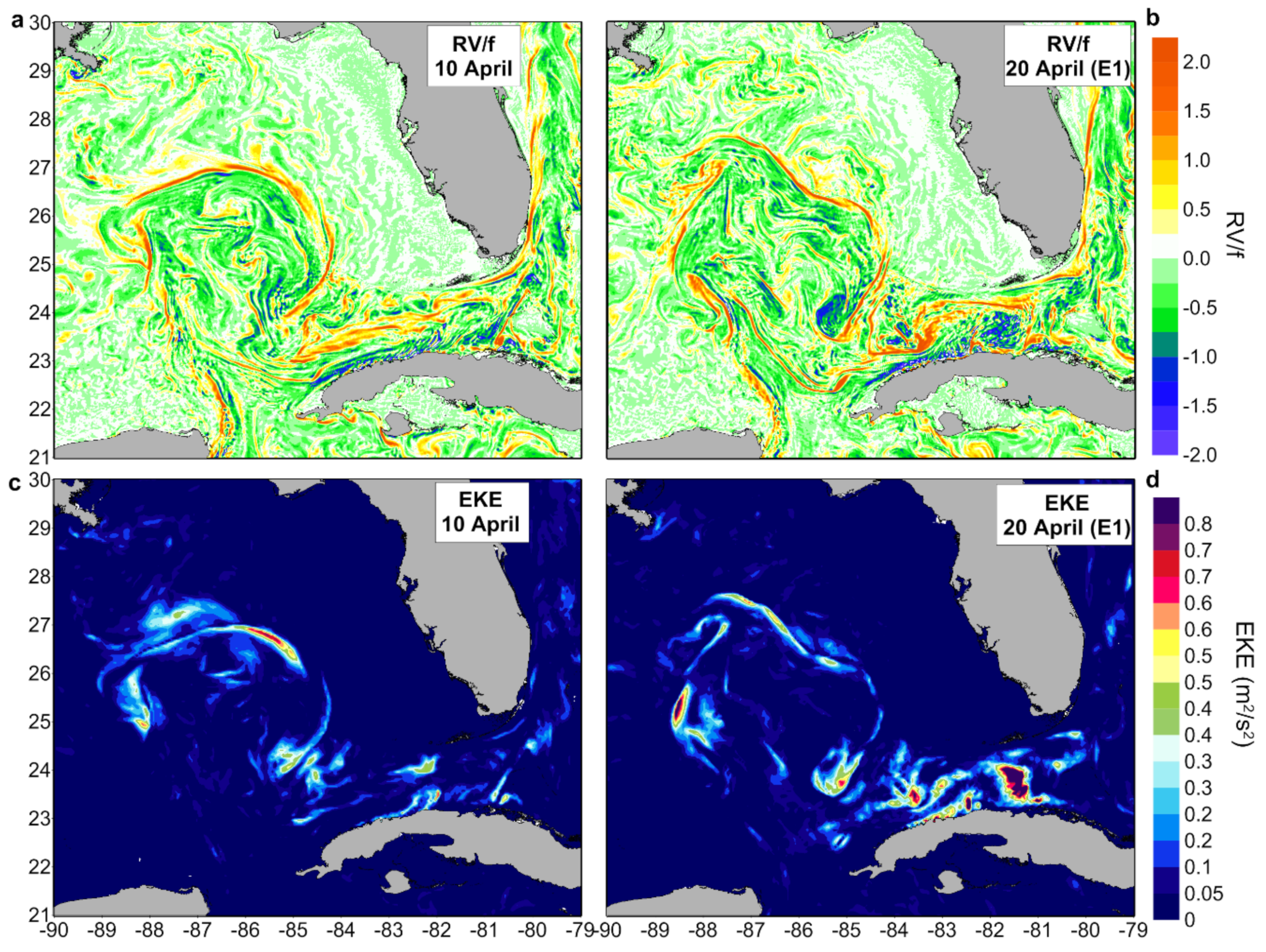
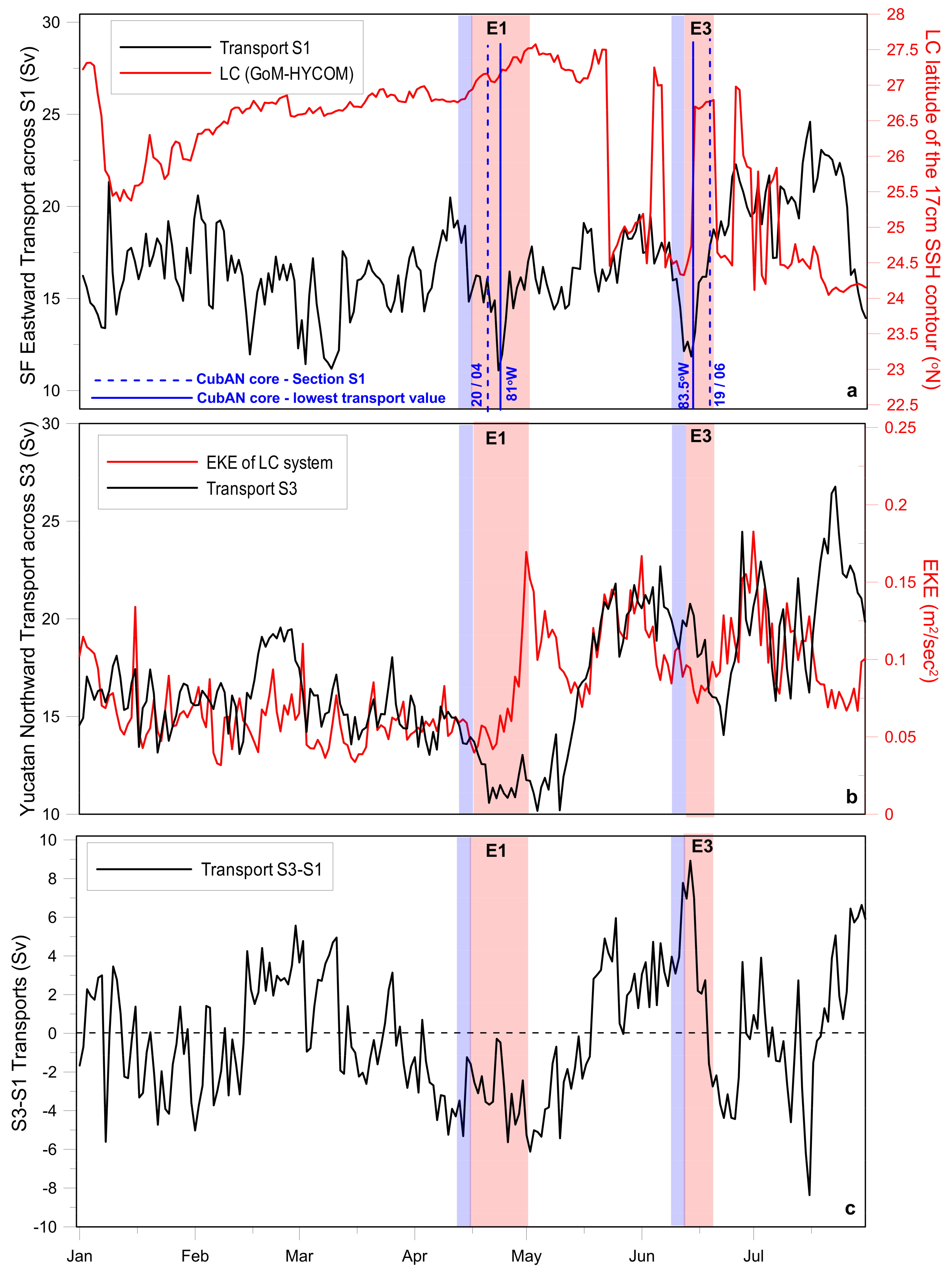
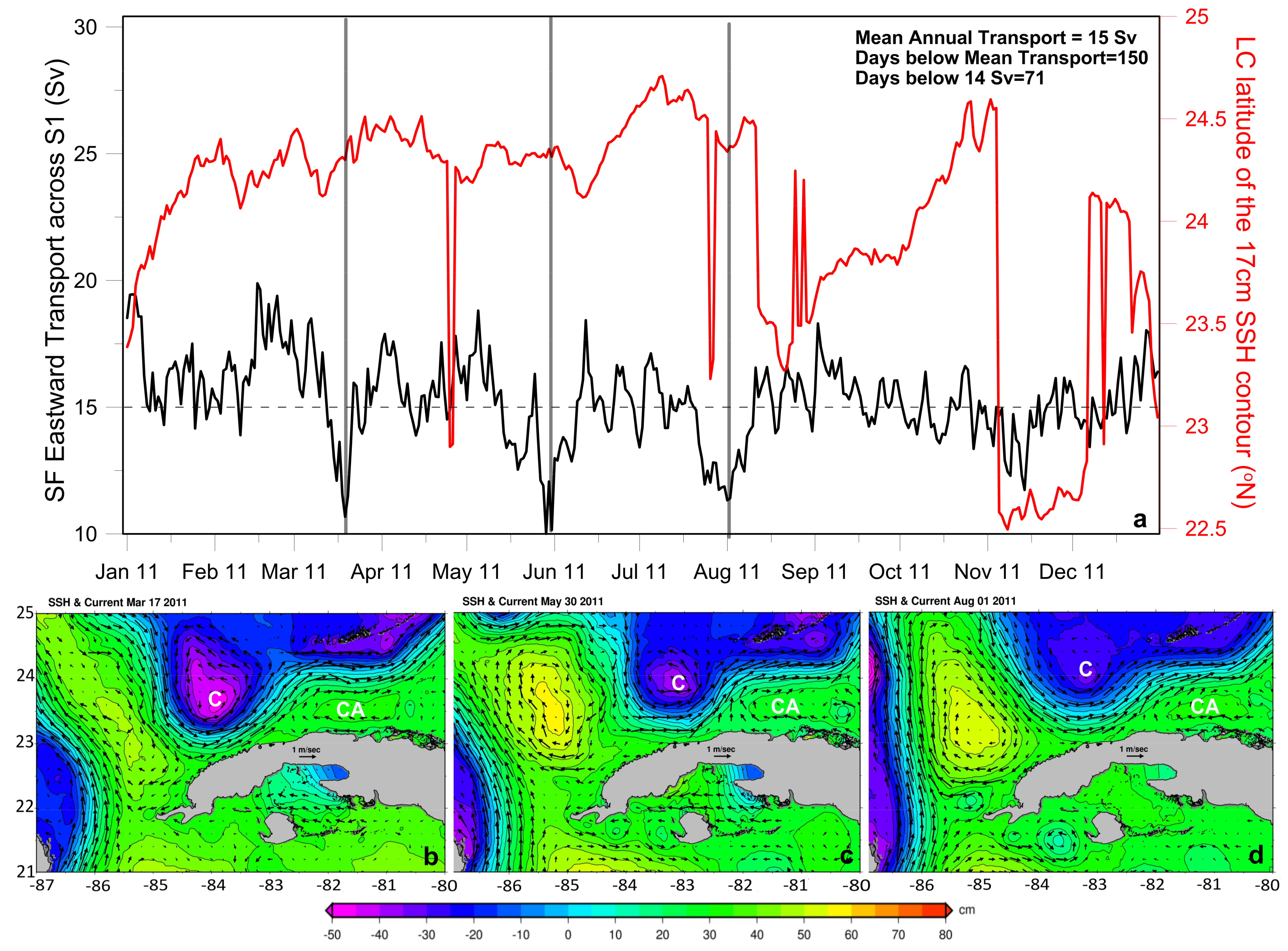
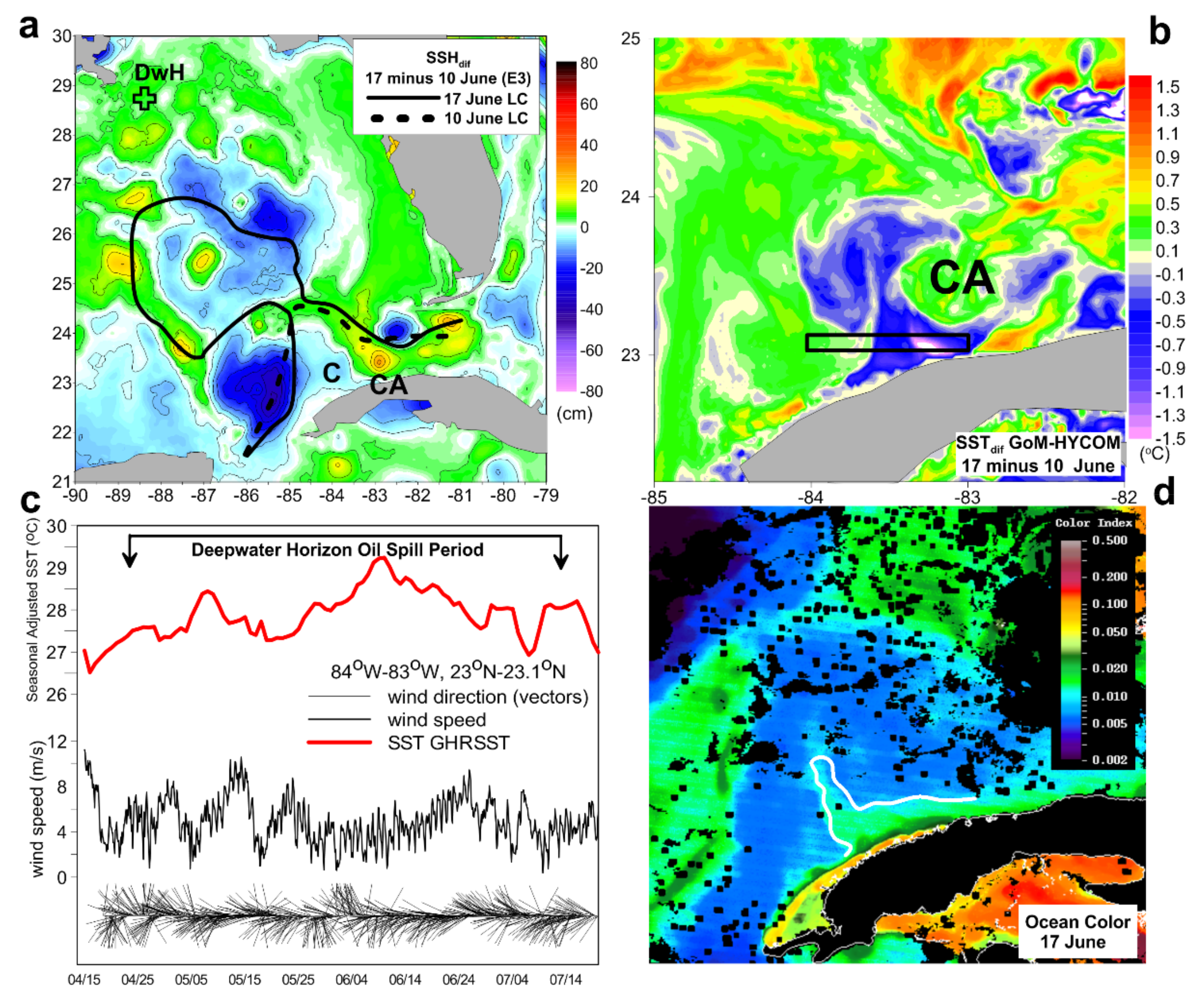
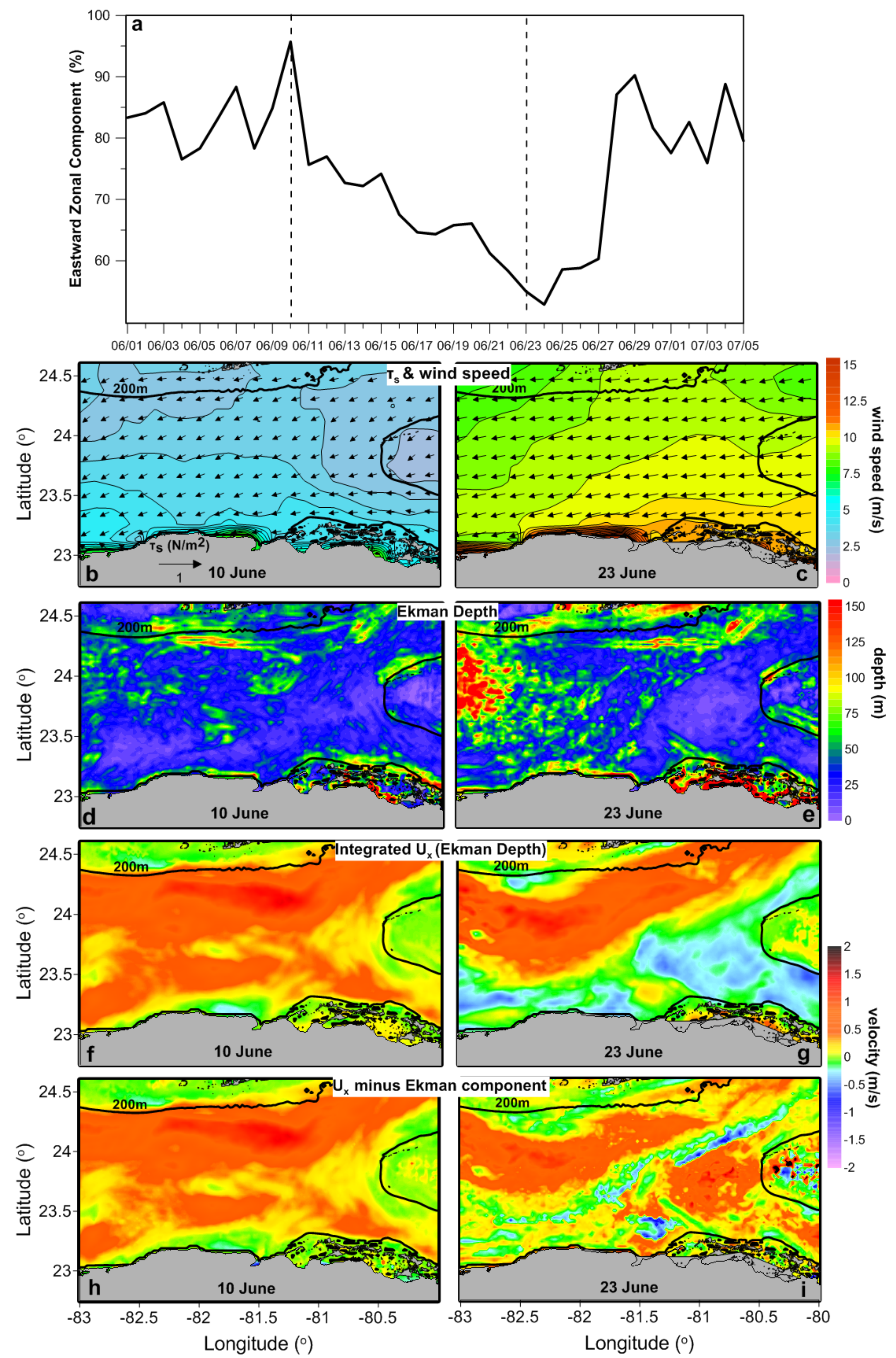
Publisher’s Note: MDPI stays neutral with regard to jurisdictional claims in published maps and institutional affiliations. |
© 2021 by the authors. Licensee MDPI, Basel, Switzerland. This article is an open access article distributed under the terms and conditions of the Creative Commons Attribution (CC BY) license (http://creativecommons.org/licenses/by/4.0/).
Share and Cite
Androulidakis, Y.; Kourafalou, V.; Le Hénaff, M.; Kang, H.; Ntaganou, N. The Role of Mesoscale Dynamics over Northwestern Cuba in the Loop Current Evolution in 2010, during the Deepwater Horizon Incident. J. Mar. Sci. Eng. 2021, 9, 188. https://doi.org/10.3390/jmse9020188
Androulidakis Y, Kourafalou V, Le Hénaff M, Kang H, Ntaganou N. The Role of Mesoscale Dynamics over Northwestern Cuba in the Loop Current Evolution in 2010, during the Deepwater Horizon Incident. Journal of Marine Science and Engineering. 2021; 9(2):188. https://doi.org/10.3390/jmse9020188
Chicago/Turabian StyleAndroulidakis, Yannis, Vassiliki Kourafalou, Matthieu Le Hénaff, HeeSook Kang, and Nektaria Ntaganou. 2021. "The Role of Mesoscale Dynamics over Northwestern Cuba in the Loop Current Evolution in 2010, during the Deepwater Horizon Incident" Journal of Marine Science and Engineering 9, no. 2: 188. https://doi.org/10.3390/jmse9020188
APA StyleAndroulidakis, Y., Kourafalou, V., Le Hénaff, M., Kang, H., & Ntaganou, N. (2021). The Role of Mesoscale Dynamics over Northwestern Cuba in the Loop Current Evolution in 2010, during the Deepwater Horizon Incident. Journal of Marine Science and Engineering, 9(2), 188. https://doi.org/10.3390/jmse9020188






